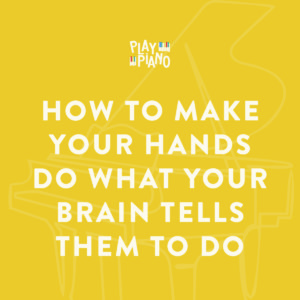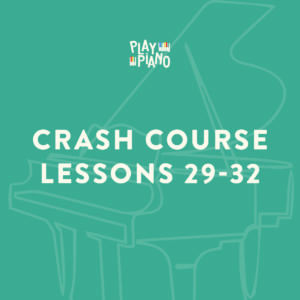Description
With this offer, you get 2 GREAT courses combined!
Course Number One: Which Finger Goes Where, And Why?
If you’ve ever wondered if you’re using the correct fingering, this instructional audio CD course will answer your questions. There is an intrinsic logic to fingering that most pianists don’t know about. It’s simple, yet requires some explanation. You’ll learn how to finger scale passages, chord sequences, chromatic phrases, and so on. But once you understand, you’ll scratch your head and say “Of course! It’s obvious now!”
The Logic of Piano Fingering
- Fingering for music phrases that move up
- Fingering for music phrases that move down
- Fingering for chromatic passages
- Fingering for scales starting on white keys
- Fingering for scales starting on black keys
- Fingering for triads
- Fingering for 4 and 5 note chords
“What fingers should I use?”
As a piano teacher for many years now, I have had countless students ask me some variation of this question: “What fingers should I use on such and such a note, or such and such a chord?”
And my answer never fails to surprise them. I tell them “Fingering is not written in stone. Moses did not hand down a commandment on fingering, and neither did Bach or Mozart or Billy Joel or Dave Brubeck”
That comes as a shock to many adults because they think back to their piano lesson days as children and recall their teacher telling them things like “Don’t use your thumb on that key!” and “Cross your 3rd finger over…” and so forth.
So while there are no absolutes when it comes to fingering, there are certainly general principles that pianists have discovered down through the years. So whenever possible, don’t re-invent the wheel. We all learn from experience, but it doesn’t have to be our experience we learn from: we can stand on the shoulders of the giants of the piano that have gone before us, and take advantage of what they have discovered.
Here are some general principles — the intrinsic logic of fingering:
- If you see a passage in your sheet music move higher on the staff, use a low finger (fingers are numbered from the thumb outward, so your thumb is #1, your index finger is #2, your middle finger is #3, your ring finger is #4, and your little finger is #5) so you’ll have fingers available for higher notes. And of course, exactly the opposite if you see a passage move lower on the staff.
- Hold your hand up in front of you. The longest fingers are in the middle — right? Your thumb is far and away the shortest because it starts at a lower point on your hand. Now look at a piano keyboard. The black keys are the furthest away from you — correct? So which fingers can reach the black keys best? You got it — your middle fingers. Therefore, whenever possible play the black keys with your long fingers instead of your thumb. It’s just common sense.
- The corollary to that is obvious: use your thumb and little finger on white keys whenever possible. (And it’s NOT always possible.)
- A scale contains 8 keys. You have 5 fingers. So it’s logical to assume you will have to use some fingers more than once. On right hand scale passages ascending beginning on white keys, start on your thumb and then cross your thumb under your 3rd finger except when the 4th note of the scale is a black key. In that case, to avoid playing the black key with your thumb, cross your thumb under your 4th finger. (And just the reverse with your left hand, of course). On scale passages beginning on black keys, start on a long finger — preferably your index finger (also called your “pointer finger”) and then cross your thumb under whenever the next white key occurs.
- On chromatic passages, the best way I have found is to use just fingers #1 and #3 except where two white keys in a row occur — then use fingers #1 and #2.
- Fingering on chords is largely dictated by the size of the chord; obviously if you are playing a 5-note chord, you will use all 5 fingers. Otherwise just follow the intrinsic logic in the general principles listed above.
P.S. If you still find it hard to believe that fingering is not written in stone, then watch any video of Art Tatum (available on YouTube.com), one of the great jazz pianists, who stunned classical musicians with his blazing speed while using extremely unorthodox fingering…
Course Number Two: How to Make Your Hands Do What Your Brain Tells Them To Do
It’s one thing for you to know WHAT to do on the piano, but it’s quite another thing for your hands to have the technique to pull off what your mind tells them to do.
This course shows you how to go about training your hands and fingers so that they will be able to do what you tell them to do. You get a classic technique book along with this CD course and Duane demonstrates how to use it for maximum benefit.
Piano technique is often misunderstood by non-pianists as a skill people are born with or a skill that requires long fingers. It’s more about learning to use your hands and fingers comfortably and how to hit desired keys on the keyboard with your fingertips. The first step toward the goal of playing piano professionally is learning proper hand and finger placements. While there are many different ways to finger chords on a guitar, the piano is linear and requires a more strict way of learning chord fingerings.
Here are just a couple things to keep in mind:
- Let the palms of your hands point down with the tips of your fingers on the keys, as if you were holding a ball in each hand. Let each thumb and fingertip rest on a separate key and work on not raising fingers after they strike keys. Concentrate on not banging on keys, but using enough force to create sounds.
- One of the most understated methods to developing piano technique is simply to relax the hands and fingers, even when stretching fingers. Ultimately, you want playing to feel effortless. One way to make finger stretching feel effortless is to practice octaves with the thumb on a low note and your pinky on the high note. Use one of your other fingers to play a note in between. Apply this practice to both hands and concentrate on building strength in your weaker hand. Even though relaxing is important, beginning piano players must still learn to deal with a certain amount of discomfort as they train their muscles to move flexibly.
- Practice stretching your fingers as far as they can go without causing pain or injury. It’s actually a good idea to relax the whole body, especially the arms and shoulders. A good way to warm up for piano is to shake your hands and arms until tension can no longer be felt. You can also use one hand to massage the fingers on the other hand. Think of each thumb and finger as having a number, with thumb being number one and your pinky being number five. This helps remind you that each finger serves its own purpose and also reduces the clumsiness beginners may initially feel.
- Other piano techniques that can improve performance involve experimenting with various pianos and synthesizers, different time signatures, accents, tempos, inversions and songs that challenge your existing knowledge. A big difference between acoustic and electric piano is that you can learn to play notes faster, giving your fingers a chance to move freely.
- Another important aspect of piano technique is memorization. Think of each finger as corresponding to a note on the keyboard even when you are nowhere near a piano. It’s a good idea to learn to play piano without watching your hands, so that you can read music while playing or singing for an audience. Imagine that each fingertip has its own brain and knows where to go without help from your eyes.
Developing piano technique does take hours of practice, which cannot be avoided if you want to become a great pianist. Practicing scales is very important in creating a sense of second nature ability that bridges music theory with the mechanics of musicianship. Learn to play major and minor arpeggios on each hand. Alternating between the thumb and first finger on scales and melodies can improve speed and rhythm. Playing piano regularly is essentially to maintain growth and smooth performance.
This course contains two Instructional Audio CDs and a Technique Book








Reviews
There are no reviews yet.